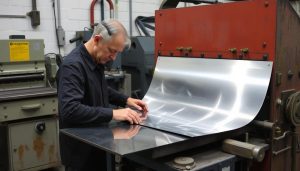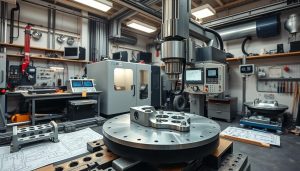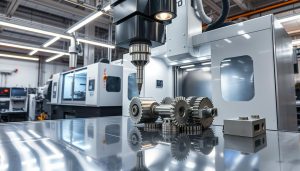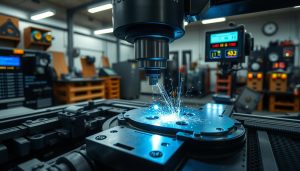In the world of manufacturing and fabrication, achieving a flawless surface finish is paramount. This is where the art of polishing surface finishing comes into play, offering a range of techniques and delivering unparalleled benefits. From enhancing the aesthetic appeal of products to improving their functionality, polishing has become an indispensable step in the pursuit of manufacturing excellence.
Polishing surface finishing is the process of refining and smoothing a material’s surface to achieve a high-quality, mirror-like finish. This meticulous process not only transforms the visual aspect of a product but also plays a crucial role in ensuring its performance and durability. Whether you’re working with metals, plastics, or even specialized materials, the right polishing techniques can unlock a world of possibilities, leading to flawless results that captivate the senses and exceed customer expectations.
Introduction to Polishing Surface Finishing
The surface finishing process is a crucial step in manufacturing and fabrication, as it directly impacts the appearance, functionality, and quality of the final product. At the heart of this process lies polishing, a meticulous technique that transforms raw materials into visually stunning and high-performing components.
What is Polishing in Surface Finishing?
Polishing is the process of smoothing and refining the surface of a material, typically metals, to enhance its aesthetic appeal and improve its physical properties. This is accomplished by removing minor imperfections, scratches, and uneven textures, creating a smooth, uniform, and reflective finish.
Why Polishing is Crucial for High-Quality Results
Polishing is essential for surface finishing as it plays a vital role in quality enhancement. By meticulously refining the surface, polishing ensures that the final product exhibits exceptional surface finishing process and a level of polishing importance that is unparalleled. This attention to detail not only enhances the visual appeal but also improves the durability, corrosion resistance, and overall performance of the material.
Whether in the aerospace, automotive, or medical industries, the quality enhancement provided by polishing is a vital component in the creation of high-quality, long-lasting, and visually appealing products. By understanding the significance of polishing in surface finishing, manufacturers can unlock the full potential of their materials and deliver exceptional results to their customers.
Different Types of Polishing Techniques
Achieving a flawless and gleaming surface finish is crucial for many industries, from metalworking to aerospace. To cater to diverse material polishing requirements, a range of specialized techniques have been developed. Let’s explore three of the most widely used polishing methods: mechanical, electropolishing, and chemical polishing.
Mechanical Polishing
Mechanical polishing, also known as abrasive polishing, involves the use of abrasive materials like sandpaper, polishing pads, and buffing wheels to gradually remove material from the surface. This polishing method is particularly effective for polishing methods, surface finishing techniques, and material polishing of a wide range of metals, including stainless steel, aluminum, and copper. By carefully controlling the abrasive grit size and polishing pressure, manufacturers can achieve a smooth, mirror-like finish on their products.
Electropolishing
Electropolishing is an electrochemical process that uses an electric current to selectively remove material from the surface of a metal part. This technique is often used for polishing methods, surface finishing techniques, and material polishing in industries such as medical devices, automotive, and aerospace, where a high-quality, uniform, and corrosion-resistant finish is essential. The electropolishing process can also improve the surface properties of the material, enhancing its overall durability and performance.
Chemical Polishing
Chemical polishing, also known as material polishing, involves the use of chemical agents to dissolve and remove material from the surface of a part. This technique is particularly useful for surface finishing techniques on complex geometries and hard-to-reach areas where mechanical polishing may not be feasible. Chemical polishing can produce a high-gloss, mirror-like finish and is commonly used in the manufacturing of medical implants, electronic components, and optical devices.
| Polishing Method | Characteristics | Typical Applications |
|---|---|---|
| Mechanical Polishing | Uses abrasive materials to gradually remove material from the surface | Metalworking, automotive, aerospace |
| Electropolishing | Electrochemical process that selectively removes material from the surface | Medical devices, automotive, aerospace |
| Chemical Polishing | Uses chemical agents to dissolve and remove material from the surface | Medical implants, electronic components, optical devices |
“The choice of polishing method depends on the material, surface finish requirements, and the specific application.”
Applications of Polishing Surface Finishing
Polishing surface finishing plays a crucial role in a wide range of industries, from metal fabrication to aerospace and automotive manufacturing. This versatile technique offers both aesthetic and functional benefits, transforming the appearance and performance of various materials.
Polishing in Metal Fabrication
In the metal fabrication industry, polishing is essential for creating high-quality, visually appealing products. It can be used to enhance the industrial polishing applications of metal components, improving their metal surface finishing and making them more resistant to corrosion, wear, and other forms of degradation.
Polishing for Aesthetic and Functional Purposes
Polishing is not solely about enhancing the aesthetic polishing of a surface; it also serves important functional purposes. By smoothing and refining the surface, polishing can improve the performance and durability of various products, from kitchen appliances to medical devices.
How Polishing is Used in Industries like Aerospace and Automotive
In the aerospace and automotive industries, polishing is essential for producing high-precision, high-performance components. It is used to create smoother, more aerodynamic surfaces on aircraft and vehicle parts, improving their efficiency and reducing drag. Additionally, polishing can enhance the visual appeal and perceived quality of these products, making them more attractive to consumers.
| Industry | Polishing Applications | Benefits |
|---|---|---|
| Aerospace | Aircraft parts, engine components | Improved aerodynamics, reduced drag, enhanced visual appeal |
| Automotive | Vehicle body panels, chrome trim, wheels | Improved aesthetics, corrosion resistance, perceived quality |
| Medical | Surgical instruments, implants | Smooth, sanitary surfaces, improved functionality |

Polishing surface finishing is a versatile and indispensable technique in a variety of industries, from metal fabrication to aerospace and automotive manufacturing. By enhancing the appearance, durability, and performance of various materials, polishing plays a critical role in delivering high-quality, functional, and visually appealing products to consumers and industries worldwide.
Surface Roughness and its Role in Polishing
In the realm of manufacturing, surface roughness is a crucial factor that can significantly impact the quality and performance of a product. This characteristic, which measures the microscopic irregularities on a surface, plays a vital role in determining the success of polishing techniques and the overall excellence of a finished product.
What is Surface Roughness in Manufacturing?
Surface roughness is a quantitative measure of the textural irregularities on a surface. It is typically expressed in micrometers (μm) or nanometers (nm) and is an essential consideration in various industries, from aerospace and automotive to medical and electronics. The surface roughness of a component can impact its aesthetic appeal, wear resistance, and even its functional capabilities.
How Polishing Affects Surface Roughness
Polishing is a crucial surface finishing process that can significantly improve the surface roughness measurement of a component. By utilizing a variety of techniques, such as mechanical, chemical, or electrochemical polishing, manufacturers can reduce the surface irregularities and achieve a smoother, more refined finish. This, in turn, can enhance the polishing impact on the overall manufacturing quality of the product, making it more aesthetically pleasing, durable, and functional.
The relationship between polishing and surface roughness is complex, as the specific technique and parameters used can have a substantial influence on the final outcome. Careful consideration of the material, desired surface characteristics, and the intended application is essential when selecting the appropriate polishing method.

“Achieving the optimal surface roughness is a delicate balance, and the right polishing approach can make all the difference in realizing high-quality, long-lasting products.”
Choosing the Right Polishing Method for Your Project
Selecting the appropriate polishing technique is crucial to achieving the desired surface finish and meeting project requirements. When determining the best polishing method, there are several key factors to consider, including the material, project specifications, and desired aesthetic.
Factors to Consider When Selecting a Polishing Technique
- Material Characteristics: The type of material, such as metal, plastic, or glass, will influence the most suitable polishing technique. Different materials may require specialized methods to achieve optimal results.
- Surface Finish Requirements: The desired level of smoothness, shine, and overall aesthetic will help guide the polishing technique selection. Some projects may prioritize a high-gloss finish, while others may require a more matte or satin-like appearance.
- Production Considerations: Factors like production volume, turnaround time, and budget can also play a role in choosing the right polishing method. Certain techniques may be more cost-effective or efficient for specific project requirements.
Which Polishing Method is Best for Your Material?
When it comes to material-specific polishing, there are several options to consider:
| Material | Recommended Polishing Techniques |
|---|---|
| Metals | Mechanical polishing, electropolishing, chemical polishing |
| Plastics | Mechanical polishing, chemical polishing |
| Glass | Mechanical polishing, chemical polishing |
By carefully evaluating the material, project requirements, and production factors, you can select the polishing technique that best suits your needs and delivers the desired material-specific polishing results.
“Choosing the right polishing method can make all the difference in the final project requirements and quality of your product.”
Shixinproto provides customized polishing solutions for various materials
At Shixinproto, we understand that every material and project has unique requirements when it comes to surface finishing. That’s why we offer a wide range of customized polishing solutions to meet the specific needs of our clients. Our team of experienced professionals works closely with customers across diverse industries, from aerospace to automotive, to deliver high-quality results tailored to their material and design preferences.
Whether you’re looking to enhance the aesthetics, improve functionality, or achieve a specific level of surface roughness, our material-specific finishing expertise ensures that we can develop the perfect polishing approach for your application. From mechanical polishing and electropolishing to chemical polishing, we have the knowledge and capabilities to select the most suitable technique for your project, guaranteeing exceptional surface quality and a flawless finish.
At Shixinproto, we take pride in our ability to provide professional polishing services that exceed our clients’ expectations. By combining our technical know-how with a customer-centric approach, we consistently deliver customized solutions that not only meet but exceed industry standards, ensuring your satisfaction from start to finish.
FAQ
What is polishing in surface finishing?
Why is polishing crucial for high-quality results?
What are the different types of polishing techniques?
- Mechanical Polishing: Involves the use of abrasive materials or tools to physically smooth surfaces.
- Electropolishing: Uses an electrochemical process to remove a thin layer of material, resulting in a bright and smooth finish.
- Chemical Polishing: Relies on chemical reactions to dissolve surface irregularities and create a polished finish.





